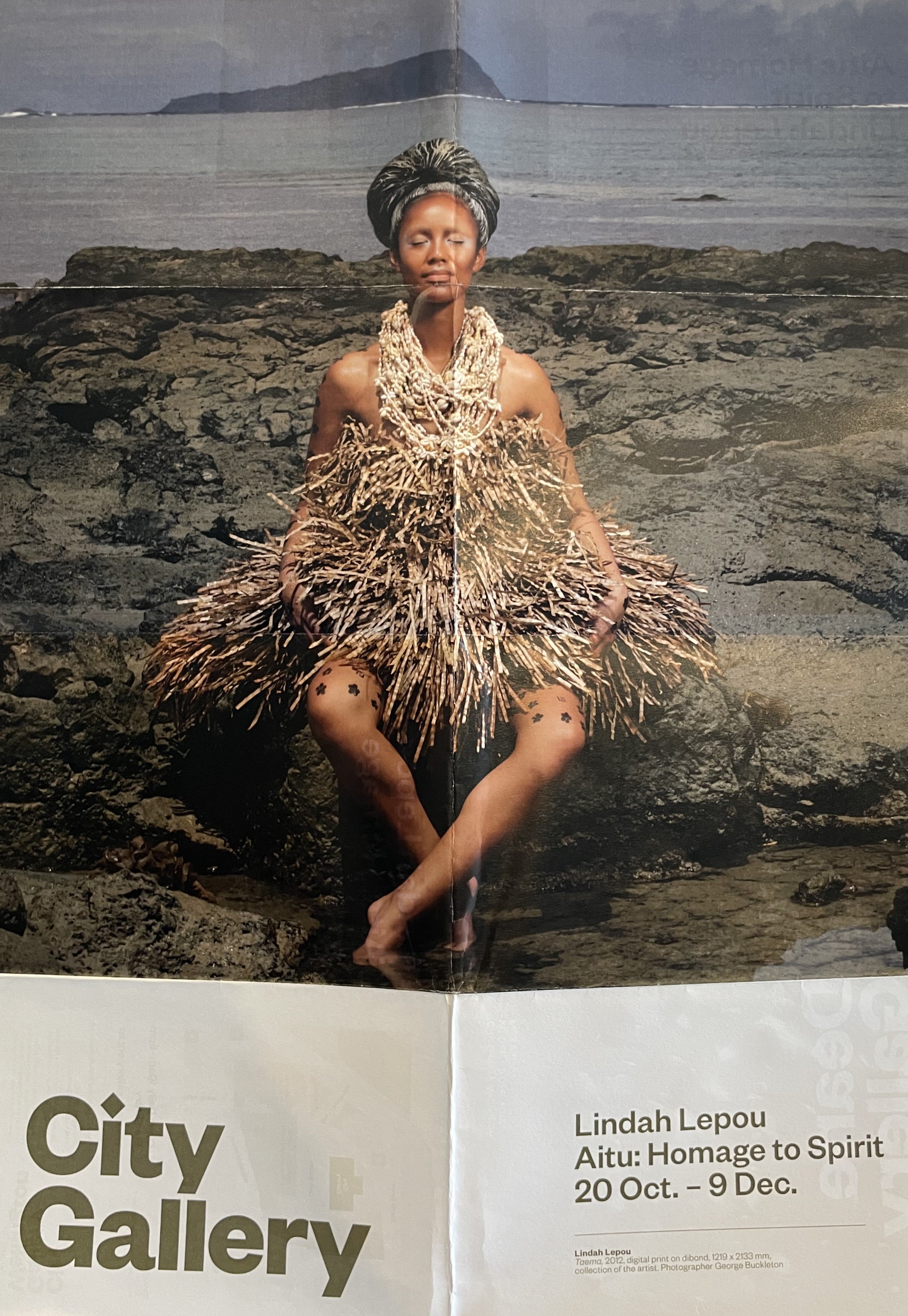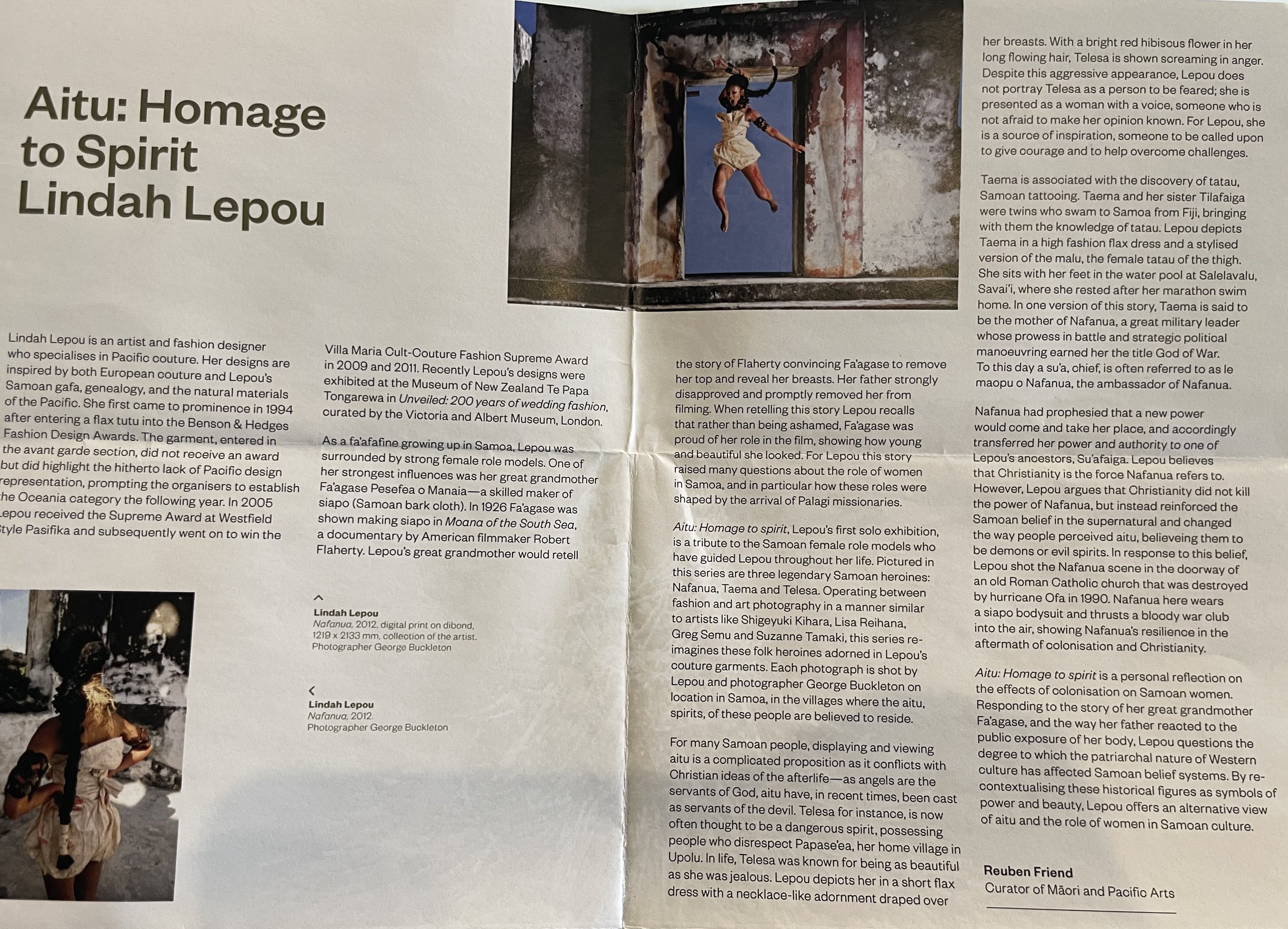Lindah Lepou: Aitu (Homage to Spirit)
City Gallery Wellington | Te Whare Toi
20 October–9 December 2012
Pacific couture designer Lindah Lepou pays tribute to three legendary Samoan aitu (ghosts, spirits)—Nafanua, Taema, and Telesa. Lepou says Christianity has tainted them, casting them as servants of the devil. But, as a young fa’afafine growing up in Samoa, Lepou saw them as role models—symbols of strength and identity who could be called upon for support. The show includes Lepou garments, and photos of models wearing Lepou garments in the Samoan villages where the aitu are believed to dwell. The photos were shot by fashion photographer George Buckleton. The show offers an opportunity to reconsider the nature of aitu and the role of women in Samoan history.
The following essay is taken from the catalogue publication that was created to accompany the exhibition:
Lindah Lepou
Aitu: Homage to spirit
Lindah Lepou is an artist and fashion designer who specialises in Pacific couture. Her designs are inspired by both European couture and Lepou's Samoan gafa, genealogy, and the natural materials of the Pacific. She first came to prominence in 1994 after entering a flax tutu into the Benson & Hedges Fashion Design Awards. The garment, entered in the avant garde section, did not receive an award but did highlight the hitherto lack of Pacific design representation, prompting the organisers to establish the Oceania category the following year. In 2005 Lepou received the Supreme Award at Westfield Style Pasifika and subsequently went on to win the Villa Maria Cult-Couture Fashion Supreme Award in 2009 and 2011. Recently Lepou's designs were exhibited at the Museum of New Zealand Te Papa Tongarewa in Unveiled: 200 years of wedding fashion, curated by the Victoria and Albert Museum, London.
As a fa'afafine growing up in Samoa, Lepou was surrounded by strong female role models. One of her strongest influences was her great grandmother Fa'agase Pesefea o Manaia—a skilled maker of siapo (Samoan bark cloth). In 1926 Fa'agase was shown making siapo in Moana of the South Sea, a documentary by American filmmaker Robert Flaherty. Lepou's great grandmother would retell the story of Flaherty convincing Faagase to remove her top and reveal her breasts. Her father strongly disapproved and promptly removed her from filming. When retelling this story Lepou recalls that rather than being ashamed, Fa'agase was proud of her role in the film, showing how young and beautiful she looked. For Lepou this story raised many questions about the role of women in Samoa, and in particular how these roles were shaped by the arrival of Palagi missionaries.
Aitu: Homage to spirit, Lepou's first solo exhibition, is a tribute to the Samoan female role models who have guided Lepou throughout her life. Pictured in this series are three legendary Samoan heroines: Nafanua, Taema and Telesa. Operating between fashion and art photography in a manner similar to artists like Shigeyuki Kihara, Lisa Reihana, Greg Semu and Suzanne Tamaki, this series reimagines these folk heroines adorned in Lepou's couture garments. Each photograph is shot by Lepou and photographer George Buckleton on location in Samoa, in the villages where the aitu, spirits, of these people are believed to reside.
For many Samoan people, displaying and viewing aitu is a complicated proposition as it conflicts with Christian ideas of the afterlife-as angels are the servants of God, aitu have, in recent times, been cast as servants of the devil. Telesa for instance, is now often thought to be a dangerous spirit, possessing people who disrespect Papase'ea, her home village in Upolu. In life, Telesa was known for being as beautiful as she was jealous. Lepou depicts her in a short flax dress with a necklace-like adornment draped over her breasts. With a bright red hibiscus flower in her long flowing hair, Telesa is shown screaming in anger.
Despite this aggressive appearance, Lepou does not portray Telesa as a person to be feared; she is presented as a woman with a voice, someone who is not afraid to make her opinion known. For Lepou, she is a source of inspiration, someone to be called upon to give courage and to help overcome challenges.
Taema is associated with the discovery of tatau, Samoan tattooing. Taema and her sister Tilafaiga were twins who swam to Samoa from Fiji, bringing with them the knowledge of tatau. Lepou depicts Taema in a high fashion flax dress and a stylised version of the malu, the female tatau of the thigh.
She sits with her feet in the water pool at Salelavalu, Savaili, where she rested after her marathon swim home. In one version of this story, Taema is said to be the mother of Nafanua, a great military leader whose prowess in battle and strategic political manoeuvring earned her the title God of War. To this day a sưa, chief, is often referred to as le maopu o Nafanua, the ambassador of Nafanua. Nafanua had prophesied that a new power would come and take her place, and accordingly transferred her power and authority to one of Lepou's ancestors, Su'afaiga. Lepou believes that Christianity is the force Nafanua refers to.
However, Lepou argues that Christianity did not kill the power of Nafanua, but instead reinforced the Samoan belief in the supernatural and changed the way people perceived aitu, believeing them to be demons or evil spirits. In response to this belief, Lepou shot the Nafanua scene in the doorway of an old Roman Catholic church that was destroyed by hurricane Ofa in 1990. Nafanua here wears a siapo bodysuit and thrusts a bloody war club into the air, showing Nafanua's resilience in the aftermath of colonisation and Christianity.
Aitu: Homage to spirit is a personal reflection on the effects of colonisation on Samoan women. Responding to the story of her great grandmother Faagase, and the way her father reacted to the public exposure of her body, Lepou questions the degree to which the patriarchal nature of Western culture has affected Samoan belief systems. By re-contextualising these historical figures as symbols of power and beauty, Lepou offers an alternative view of aitu and the role of women in Samoan culture.
By Reuben Friend
Curator of Māori and Pacific Art
Lindah Lepou was raised in Samoa and moved to Aotearoa New Zealand in 1992. She studied fashion design at Bowerman School of Design, Wellington and in 1994 her first design, Flax tutu, was accepted into the Benson & Hedges Fashion Design Awards. Flax tutu was subsequently purchased by the Musuem of New Zealand Te Papa Tongarewa and is currently on display in the exhibition Tangata o le moana: The story of Pacific people in New Zealand. Her designs have been shown around the world including at New York and Dubai Fashion Weeks, the University of Cambridge, and most recently the 2012 London Pacific Fashion Show.
In making this exhibition Lepou would like to acknowledge her creative team: photographer George Buckleton, creative assistant Louina Fifita, makeup director Abbie Gardiner, hair director Freddy Neemia, film director Ramon Te Wake, producer Terina Evaga, director of photography and sound operator Samarah Wilson, music composer Robert O'Brien, recording technician and opera singer Aivale Cole, film editor Jack Woon, and model Brooke Evaga. City Gallery Wellington and Lindah Lepou also acknowledge the support of Creative New Zealand in the production of these artworks.





















